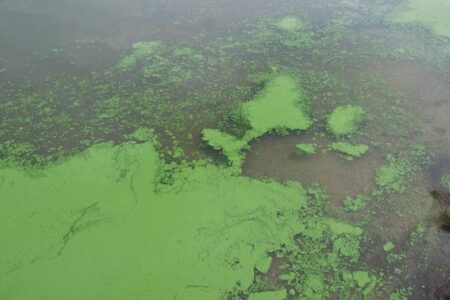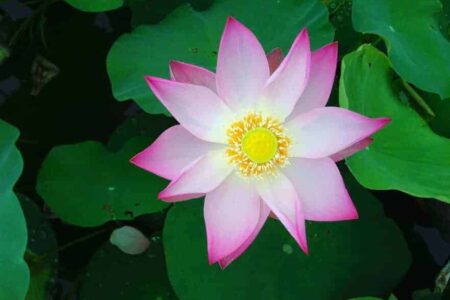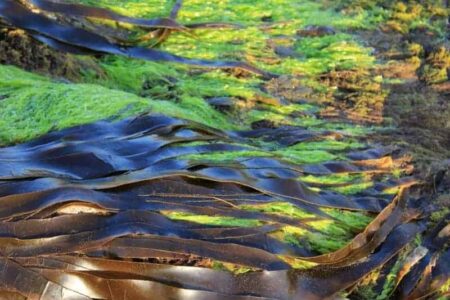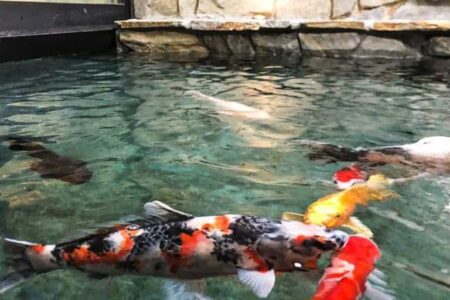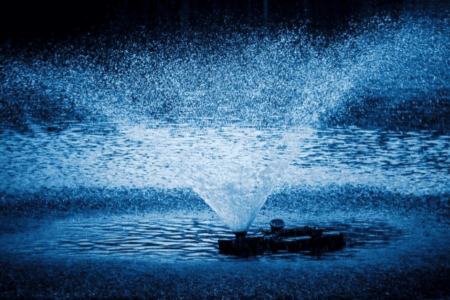Believe It Or Not, You Can Actually Use Fish Waste For Plants Or Your Organic Garden.
According to aquatic specialist Dave Glenn from Lake Management Inc., an aquaponics system can grow both aquatic plants and koi fish that are harvested in a sustainable way.
Here is how the process works: Typically koi fish are raised in backyard ponds, troughs, or indoor tanks. The fish produce excrement. The waste and water from the tank flow into a hydroponics tray where plants are grown in water without any soil. This waste is a rich fertilizer for plants despite being toxic to fish. As nutrients are absorbed by the plants, the water is purified by the water for the fish. This clean water then can be recycled into the fish tank
Since no chemical fertilizers or pesticides are used that could harm the fish, this is a completely organic and natural production system. One can utilize this system to grow beautiful aquatic plants, and to fertilize your organic fruits and vegetables.
According to Glenn, just about any type of plant can be grown using this type of system. the easiest to grow are leafy greens like arugula, Swiss chard, kale, and lettuce. Herbs can also be grown like chives, mint, and basis. Other crops include potatoes, red onions, squash, beans, peppers, cauliflower, cabbage, tomatoes, eggplant, snow peas, shallots, and cucumbers, even legal hemp or cannabis.

A Brief History Lesson On Aquaponics
Aquaponics, which started in ancient Mexico and China, is becoming increasingly popular all over the world as a local food production method, Glenn reports. He fields questions regularly from people who are interested in starting a small-scale aquaponics operation in their backyard koi ponds, and sometimes commercial-scale aquaponics farms as well for legal hemp and cannabis farms. Hobbyists can get started with aquaponics kits that are available in hydroponics supply stores as well as online.
Variations Of Aquaponic Systems
There are different types of aquaponics systems. Those that are more of a decorative koi pond or similar with an aquaponics attachment meant for a home garden. Or that of a commercial aquaponics system which is built specifically for performance vs looks. All aquaponic systems are comprised of a soil-free bed for growing the plants, and an outdoor pond, trough, or fish tank. The fish tank may be made out of plastic, concrete, glass, or fiberglass. Containers can range greatly in size from 20-40 gallon plastic totes up to big plastic aquariums that are 6-10 feet wide and 4-5 feet deep. Kits work best in temperature-controlled environments inside a house or a greenhouse says Glenn, but you can still attach a basic aquaponic setup to your outdoor backyard pond or natural fountain filtration. Ideally the plant bed should be filed with pebbles made out of gravel or clay, or the plants can be grown on bamboo rafts or foam that float on top of the water.
Be Sure To Have The Full Aquaponics Setup
In addition to the bed and tank, each system also depends on these customizable components: an aeration system, a water sump, a pump, a biofiltration system for growing beneficial bacteria for breaking down fish waste, and an area for removing solids. The water sump is a type of reservoir where water gets collected and then gets returned to the systems via the pump.
Depending on the species of fish that you select, you might need to add some kind of heater so the water temperature is kept right for the plants and fish if located in a cold state. Those located in Orange County Southern CA can most likely go without a pond heater. If you do live in a cold region, Inexpensive heat supplies are often used by aquaponics farmers like hot compost or solar greenhouses.
Glenn says the system needs to be monitored to ensure everything is running smoothly and stays in balance. You must pay close attention to if your fish are eating or not, whether or not the water is circulating correctly and how your plants are growing.
In addition to plants and fish, one other crop is naturally produced by an aquaponics system – “good” bacteria where the toxic components contained in fish waste are converted into nutrients that are consumed by the plants. These bacteria do not need to be added, but Glenn suggested that you get a testing kit so you can monitor the water’s nutrient and oxygen levels.

What Type Of Fish To Use For Your Aquaponic System
The fish that is the most commonly raised in aquaponics systems is tilapia but you can still use koi fish waste if you have a koi pond or water garden. Glenn also recommends crayfish, Murray cod, barramundi, goldfish, sunfish, koi, common carp, trout, and catfish. He advises choosing freshwater species. Each species can be fed a standard diet made just for them that can be found at pet stores or feed suppliers. In order to raise tilapia and other types of fish, including for personal use, you will need to buy a transport permit from the local warden of the Fish and Wildlife Department. It is easy to obtain these permits online or from a licensed fingerling seller.
If you are interested in building an aquaponics pond or attaching one to your existing water features you can reach us at [email protected] or (714) 312-1260
Original Content Source: www.lakemanagementinc.net

